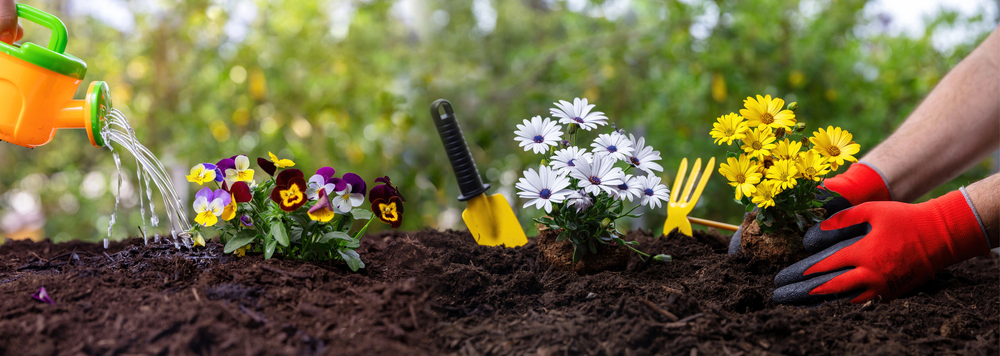Practical Gardening Tips for Retirees with Limited Space

Can a tiny balcony or a narrow backyard really become a restful, low-effort retreat? This guide answers that question with clear, friendly steps retirees can follow to enjoy the outdoors without heavy work.
Retirement often brings more free time and a chance to reconnect with nature. About 40% of U.S. home gardeners are over age 50, so many find joy in planting again.
This short guide shows how containers, vertical features, mulch, and simple watering systems let a modest garden feel lush. It focuses on low-maintenance choices that save energy and reduce bending.
Readers will learn how to shape a balcony vignette or a small backyard corner that boosts mood and movement. The advice suits gardeners at any skill level and scales up slowly.

Key Takeaways
- Start small and pick hardy plants to cut upkeep.
- Use containers and vertical elements to expand usable space.
- Choose mulch and automated watering to save effort and time.
- Design corners that encourage short, restorative outdoor sessions.
- This guide balances beauty and ease for lasting benefits.
Why small space gardening suits retirees today
Many older adults find that a compact plot offers big rewards without heavy labor. About 40% of home gardeners in the U.S. are over age 50, which shows how appealing a right-sized garden can be.
A small space is easier to manage, so chores stay short and satisfying across the year. Native plants, mulch, raised planters, and drip irrigation cut routine work while keeping plantings vibrant.
Clear boundaries make it simple to see what each bed or pot needs. That helps prevent small problems from becoming bigger ones and saves time.
- Compact areas encourage intentional design so every pot or corner serves a purpose.
- Fewer square feet makes upgrades like drip lines and waist-high beds affordable and impactful.
- Smaller plots make trying new layouts easy—changes are quick to test and enjoy.
Retirees can turn a balcony or small backyard nook into a restful spot with a few well-chosen plants and features. For step-by-step ideas, see this easy garden guide.
Vertical Gardening Ideas for Tiny Spaces
Stacking plants vertically makes a small balcony feel larger and more productive. It keeps the floor clear for seating and walking while adding layers of color and yield.

Wall planters, hanging baskets, and tiered stands
Wall-mounted planters, hanging baskets, and tiered stands multiply usable area. They turn a narrow patio or window into a layered garden that is easy to maintain.
Easy trellising with bamboo teepees
Three bamboo poles lashed with twine make a simple teepee trellis. It supports cucumbers, peas, and edible flowers such as nasturtium while taking almost no floor space.
Mind sunlight and weight limits
Check how sunlight moves across a railing during the day, especially in summer. Spread out pots so one spot does not bear all the weight.
- Choose lightweight soil mixes and small planters to ease handling.
- Use compact climbers and trailing plants to free the ground area.
- Install trellises early so vines climb neatly and yields stay easy to reach.
Result: a tidy vertical wall that adds privacy, blooms, and fresh produce in a small amount of space.
Container Gardening and Raised Bed Planters: the most flexible small-garden option
Container planting turns a tight porch or balcony into a lively, easy-care display. Lightweight containers, raised planters, and window boxes make daily tasks gentler. They reduce bending and keep pots at a comfortable reach.
A practical soil mix improves health and saves time. Blend garden soil, compost, and coco coir to create a mix that drains yet holds moisture. That balance helps roots breathe and makes watering more predictable.
- Flexible option: containers let someone shift pots to catch sun or shelter plants during a cold snap.
- Easier care: pots and raised planters reduce bending and protect joints.
- Smart soil: garden soil + compost + coco coir keeps roots aerated and holds water between watering cycles.
- Plant health: isolated planters allow tailored watering and feeding for different plants.
- Design benefit: mixed pot sizes add depth and keep pathways clear while making maintenance simple.
Portable containers also let someone swap seasonal plants quickly. Because soil is controlled, pests and diseases are easier to spot and manage early. Overall, this option brings color and function to any small garden without heavy work.
Design Your Small Garden Space for Impact and Ease
Smart composition makes a tiny plot feel thoughtful and calm. Mix heights, repeat textures, and leave breathing room so each plant can reach its best growth.

Shape, color, and room to grow
Start simple: pick one to three flower colors and let varied leaves provide most of the visual interest.
- Layer heights: low mounds, mid planters, and trellised vines create a clear way for the eye to move.
- Choose compact varieties that fit the plot but still offer blooms or scent.
- Leave space between plants so roots and foliage do not crowd as they mature.
Unify the scene by repeating foliage textures and keeping pots or decor in a matching material or hue. Position the most striking container at seated eye level so it rewards short breaks outdoors.
Edit often — remove spent annuals and refresh planters to keep maintenance low and the garden coherent as plants change through the season.
Watering Made Simple: Mulch, Drip Lines, and Less Bending
Smart mulch and targeted irrigation cut chores and keep soil happy. A 2–4 inch layer of organic mulch conserves moisture, suppresses weeds, and slowly improves soil as it breaks down.
Combine mulch with efficient delivery to reduce bending and daily fuss. Drip lines and soaker hoses send water straight to roots, and timers keep the schedule steady on hot summer days.
Mulch depth and benefits
Apply 2–4 inches of organic mulch around containers and beds. This helps the garden hold water longer and keeps roots cool.
Drip irrigation and timers
Drip lines and soaker hoses reduce waste and lower disease risk by avoiding wet foliage. Simple plug-in timers take the guesswork out of each day and are handy during travel.
When to water and how to group plants
Water early in the morning; late evening works on very hot days to cut evaporation. Group plants with similar moisture needs to streamline care and avoid over- or under-watering.
- Short, deep watering builds stronger roots better than frequent shallow sprinkles.
- Elevate hoses off walkways and use quick-connect fittings to reduce bending.
- Check soil with a finger test before running a cycle to prevent unnecessary water use.
| Method | Key benefit | Ease of use |
|---|---|---|
| Mulch (2–4 in) | Conserves water, suppresses weeds, enriches soil | Low — spread annually or as needed |
| Drip lines / soaker | Targets roots, reduces waste | Medium — initial setup, then low |
| Timers | Consistent schedule, helpful during travel | Easy — plug and set |
Result: a clear watering plan makes garden care calmer and more predictable. These small steps save effort while keeping plants healthy through the season.
Plant picks that thrive When Gardening in Small Spaces
A smart plant list reduces chores while keeping color, scent, and small harvests within reach. Choose compact selections so each pot or bed earns its place and needs less fuss.
Native and drought-tolerant choices
Lavender and ornamental grasses lower water use and add texture. Sedum and coneflower handle lean soil and cooler summers without extra work.
Hostas do well where sunlight is limited and ask for little care. These perennial backbones resist common pests and keep the plot steady year to year.
Herbs and edible flowers that fit pots
Herbs such as basil, mint, and thyme thrive in containers and are handy at meal time. Edible flowers like nasturtium trail or climb and add color plus a peppery bite.
- Pick compact varieties that still deliver fragrance or harvests.
- Consider patio tomatoes or chilies for a small fruiting option.
- Group by water and light needs to keep weekly care simple.
For more guidance on choosing the right plants for tight areas, consult a trusted plant selector to match varieties to the exact space and conditions.
Low-maintenance Plants, Ground covers and Lawn Alternatives
Low-growing plantings can replace a thirsty lawn and still feel soft underfoot. These choices lower routine work and add visual interest across small areas.
Creeping thyme, clover, and sedum shine in tight spots
Creeping thyme forms a dense, fragrant mat that blooms purple in summer. It tolerates light foot traffic and gives the garden a pleasant scent during warm months.
Clover stays green and helps soil by fixing nitrogen. It brings low-care resilience and reduces the need for fertilizer in small backyard patches.
Sedum tolerates poor soil and very modest water needs. Its tidy habit offers structure and color where typical turf struggles.
- Creeping thyme creates a soft, scented carpet and shows summer blooms.
- Clover improves soil and keeps green cover with little extra care.
- Sedum needs little water and thrives in lean conditions.
- Replacing lawn strips cuts mowing and watering while keeping the garden inviting.
- Ground covers help stabilize slopes and soften paths between stepping stones.
The overall benefits include better soil life, calmer routines, and a more interesting garden floor. Mixing thyme, clover, and sedum is a great option when mowing is awkward and fewer weekly chores are desired.
Gardening tips for retirees with limited space
Short, regular routines keep a small patio healthy without tiring anyone out. A few minutes each day and one short session each week make care predictable and gentle.
Daily and weekly rhythms that fit energy levels and seasons
Daily: a five-minute walk-through checks moisture, removes a couple of weeds, and notes any pests or blooms to harvest. Small notes on a phone or notebook help track changes.
Weekly: spend 20–30 minutes pruning, tidying pots, and topping up mulch or fertilizer. Prioritize water, harvest, and deadheading so each visit makes a clear difference.
Accessibility and safety: waist-high beds, clear paths, and lightweight tools
Use waist-high beds and sturdy planters to bring work to a comfortable level and reduce bending. Keep paths even and uncluttered so movement feels safe and steady.
- Choose lightweight tools with cushioned grips and keep a small kit in a weatherproof box nearby.
- Group pots by water needs to simplify one-pass care and limit lifting.
- Celebrate small wins weekly—fresh herbs at dinner or a neat corner—to stay motivated.
For more practical ideas on adapting a home plot to match energy and safety needs, see this helpful guide at gardening for seniors.
Conclusion
A well-planned tiny plot can deliver steady joy and healthy plants all year. Match plant choices to sunlight and space, set up raised beds or containers to control soil and reduce bending, and use drought-tolerant varieties like lavender and sedum to cut routine care.
Apply 2–4 inches of mulch, install drip or soaker lines on a timer, and water in the early morning or evening to save water and block weeds. Add creeping thyme or clover as ground alternatives to lawn. Keep a short weekly checklist—water deeply, prune, and tidy pots—to turn many small actions into calm, steady progress. , These simple moves help gardens stay beautiful, low-effort, and rewarding all season.
Benefits of Gardening for Seniors in Limited Space
What are the benefits of gardening for seniors with limited space?
Gardening provides numerous benefits for seniors, including physical activity that promotes mobility and strength, mental stimulation that enhances cognitive function, and emotional well-being through nurturing plants. In limited spaces, seniors can still enjoy gardening by using raised garden beds or container gardening, which allows them to grow a variety of plants without needing extensive outdoor areas.
How can older gardeners maximize their small garden space?
Older gardeners can maximize their small garden space by utilizing vertical gardening techniques, such as trellises or wall planters, that allow them to grow upwards instead of outwards. Additionally, choosing easy-to-grow plants and integrating containers can help create a flourishing garden in a limited area, making the most of available sunlight and space.
What are some easy-to-grow vegetables for a vegetable garden in a small space?
Some easy-to-grow vegetables that thrive in small spaces include leafy greens like spinach and lettuce, as well as compact varieties of cucumbers and tomatoes. These plants can be grown in raised beds or pots, providing fresh and nutritious produce without requiring extensive garden area.
How can indoor gardening benefit older people?
Indoor gardening offers older people the chance to engage in gardening activities year-round, regardless of outdoor conditions. By using led grow lights and low-maintenance plants, seniors can nurture their indoor herb garden or small flower arrangements, enriching their living space and providing a sense of purpose.
What gardening tools are best for seniors with limited mobility?
Seniors with limited mobility should consider long-handled garden tools, such as trowels and weeders, which reduce the need for bending and stretching. Ergonomically designed tools can also make gardening activities more comfortable and accessible, enabling older gardeners to maintain their gardens with ease.
Are there gardening activities suitable for people living with dementia?
Yes, gardening activities can be beneficial for people living with dementia, as they provide sensory stimulation and promote a sense of achievement. Simple tasks like watering plants or picking herbs can engage their senses and create a calming routine, making gardening a therapeutic activity for those affected by cognitive decline.
How can raised garden beds improve drainage for a successful garden?
Raised garden beds improve drainage by allowing excess water to flow away from the roots of plants, preventing waterlogged soil and promoting healthy growth. This is especially important in small spaces where poor drainage can be a challenge, ensuring that plants receive the right amount of water and nutrients for a thriving garden.
What types of herbs can be grown in a small herb garden?
A small herb garden can accommodate a variety of herbs such as basil, parsley, thyme, and mint. These herbs are not only easy to grow in containers but also enhance meals with fresh flavors. Growing herbs in limited space provides older gardeners with the opportunity to enjoy gardening while adding fresh ingredients to their cooking.



